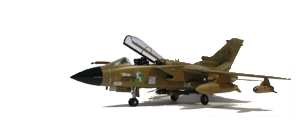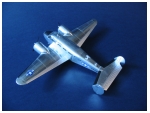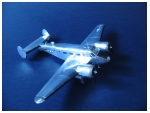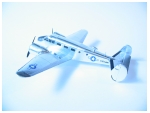




This is Kitechs 72nd scale offering which looks to be quite similar to a Hobby Craft kit which was released some time ago.
This is my first Kitech kit and I was quite surprised at the quality which was offered considering how cheap the kit was. The sprues are free from flash and the is some nicely done surface detailing which comes out very nicely.
A few of the parts are very basic and look out of scale (like the engine exhausts) however it would have to be said that the kit still offers good value for the price. Two decal options are included; one for the US and the other for a Canadian aircraft, decals were printed reasonably well and went down with no problems.
I should mention that the clear parts on my kit were horrid, there were covered in some kind of glue-type film which made them look like splotchy smoked glass.

Because this was a cheaper kit I figured it would be a good candidate to try and cover with kitchen foil. My previous attempt was a F-100 which didn't quite turn out as good as I hoped but I did learn a few things and was keen for another crack at it.
Using kitchen foil to cover a (even small 1/72 scale) kitset takes a long time, a really really long time so it's best to have this one on the shelf so you can pull it down and apply a few panels when you feel up to it. I would say it took me around 5 hours total to foil this kit, which was spread over a week.
I use Microscale's Metal Foil Adhesive which looks like a white glue that dries reasonably quickly, I haven't tried any other glue out there as I've had good results with this stuff.
I've found the easiest way to foil an aircraft is not to apply the glue to the foil first, but apply it to the kit.
I spread a (very) thin layer of the glue over one panel of the kit then brush until there is a thin and even layer of glue, there should be no brush marks. Then wait 20seconds or so for the glue to dry at which time it essentially dissappears and makes the surface tacky.
Then I cut out a section of foil slightly larger than the panel that it's going to cover and place it down on gently on the panel. Using a Q-tip I think work from the center of the panel and gently work the foil down so that it covers the panel and starts to sit in the panel lines. Once the foil is stuck on the panel I use a new blade and gently trim off the remaining foil, this part is made a lot easier due to the glue being placed on the kit panel rather than on the foil. Because we're trimming the foil on the panel lines there are also no visible cut lines in the foil.
It's best to start on the bottom of the wings where you should have a few nice panels to learn on which are not going to be that visible. Thinking forward will also help. Sections with nasty curves (like engine cowling) take a bit more work, I found it's best to either cut the foil as it's being applied to the surface, or cut small sections and apply them individually.
Don't worry too much about pushing the foil into the panel lines at this stage, it's best to wait until the next day when the glue has fully dried then using a toothpick to pick out the panel details. I found that burnishing the panel details right after placing the foil can cause air bubbles and all sorts of other issues.
I also applied the foil shiny side down on a few panels and control surfaces which made it look a little more interesting.

By the time I'd completed all that foiling I wasn't so keen on doing a whole lot of finishing so I was pleased to find that there were only a few decals to apply. The decals went down with no troubles at all, mostly due to the smooth surface of the foil I should think.
Check out our new Online Scale conversion tool. Convert from any scale in any unit of measurement to any other scale in any other unit.